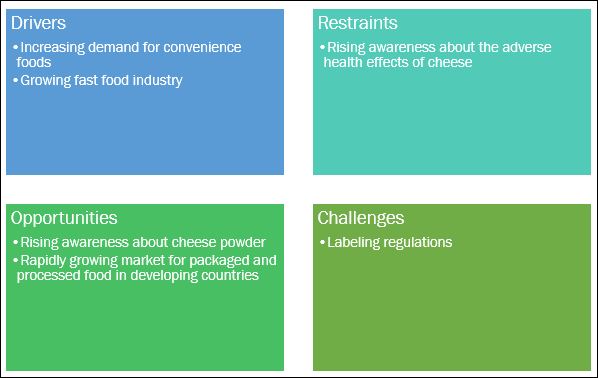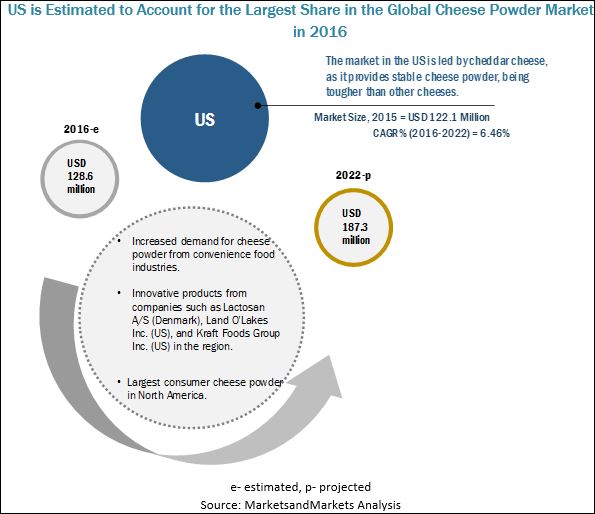The cheese powder market was valued at USD 406.6 million in 2016 and is projected to grow at a CAGR of 6.82%, to reach USD 604.1 million by 2022. Cheese powder has witnessed significant demand in recent years due to the increase in the size of the convenience & fast food industry and focus of cheese powder manufacturers on developing innovative offerings. The growth rate in the fast food industry is experiencing a surge due to the changing lifestyles of individuals around the globe. However, increasing awareness pertaining to the adverse effects of cheese on the health of consumers, such as obesity, high cholesterol levels, and heart problems are posing significant challenges in the market.

Rising demand for convenience food and growing fast food industry to drive the global cheese powder demand to touch USD 604.1 million by 2022
Cheese powder is dried/dehydrated cheese in powdered form which has numerous applications in the manufacturing of food products such as sweet and savory snacks, sauces, dressings, dips, and ready-to-eat meals. They enhance the aesthetic appeal and organoleptic properties to products, such as texture and taste. The most widely used cheese powders in the market are cheddar, mozzarella, parmesan, American cheese, and blue cheese.
Stringent labelling policies and regulations act as the major challenge for the market
The US Government has stringent policies for the labeling of packages containing cheese products. While packaging cheese products, the label must contain the accurate process through which the cheese has been processed and manufactured, such as ‘pasteurized’, ‘processed’, or ‘blended’. It is also necessary that any cheese made from vegetables/ fruits/ meat should be labeled by these items. The regulation states that there should also be a standard font size on the labels, making it easily readable to the consumers. Adhering to various labeling regulations may increase the cost of packaging and labeling, which, in turn, affects the price of the final products. This can lead to low acceptance by consumers, which poses as a challenge for the cheese powder market.

The demand for cheese powder is high in the region, owing to the rising consumption of fast food among people. Kraft Foods Group, Inc. (US) is one of the major producers of cheese powder in the US, and supplies cheese powder to the food manufacturing industry. In 2016, Europe and North America are collectively estimated to account for more than 70% of the global cheese powder production. Countries such as the US and those in the European Union are the largest cheese powder exporters in the world.
Rise in convenience food demand and lower cost of cheese powder production in Asia-Pacific offers growth opportunities to the cheese powder manufacturers
Japan is estimated to constitute the largest country market in the Asia-Pacific region in 2016. Large-scale raw material production in the Asian countries has led to a large-scale production at a competitive cost of cheese powder in the country. In 2016, North America is estimated to be the largest market share globally, as it is the largest producing and exporting region of cheese powder.
This report includes a study of marketing and development strategies, along with the product portfolios of leading companies. It includes the profiles of leading companies such as Lactosan A/S (Denmark), Land O’Lakes, Inc. (U.S.), Kerry Group Plc (Ireland), and Kraft Foods Group, Inc. (U.S.).
Make an Inquiry:
https://www.marketsandmarkets.com/Enquiry_Before_BuyingNew.asp?id=103908380
Key questions:
- With parmesan cheese powder expected to gain more traction, how will this affect the food industry in the next five years?
- What will be the prominent revenue-generating pockets for the market in the next five years?
- Most of the suppliers have opted for expansion and mergers & acquisition as key strategies, as could be seen from the recent developments. Where will it take the industry in the mid to long term?
- What are the upcoming substitutes and trends that will have a significant impact on the market in the future?
